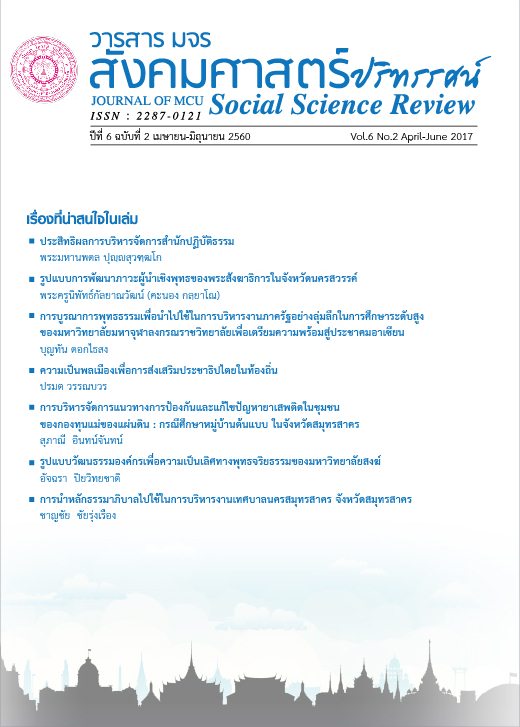THE BUDDHIST LEADERSHIP DEVELOPMENT MODEL OF SANGHA ADMINISTRATOR IN NAKHON SAWAN PROVINCE
Keywords:
Model Development Buddhist Leadership Sangha AdministratorAbstract
The Objectives of this research were; 1 To study the general Buddhist leadership of Sangha Administrator in Nakhon Sawan, 2. To study theories and Buddhadhamma about Buddhist leadership development of Sangha administrator and 3. To propose a model of Buddhist leadership development for Sangha Administrator in Nakhon sawan province.
Methodology was the mixed method; The qualitative research collected data from 25 key informants, purposefully selected, with the structured in-depth-interview, by face-to-face-interviewing. Data were analyzed by descriptive interpretation. The quantitative research collected data from 264 samples from 264 monasteries at 15 districts in Nakhon sawan province with questionnaires and analyzed data by descriptive statistics; frequency, percentile, mean and standard deviation, SD.
The Findings were as follows:
- General Buddhist leadership status of Sangha administrator maintained minimum level of Pali and Dhamma, ordained years over 5 rain retreats with experiences in monastery administration, good conducts by Dhamma and Vinaya, knowledge and ability to manage monasteries and Sangha affaires, good social relationship skills, respectable behavior, service mind to help develop villagers’ careers, developing monks and novices to have ability to teach and to train laities that people paid respect.
They were cleaver, brave to build network with people, communities and other agencies in the areas, able to lead and urge people to participate in monastery development and other activities, urged and encouraged monks and novices to continue higher education in order to have more knowledge and capacity, dared to make decision and think creatively.
- Buddhist leadership of Sangha administrator in Nakhon Sawan Province according to seven aspects of Sappurisadhamma by over all were at high levels that could be classified from highest to lowest level as; Attanyuta was at highest level, secondly, Dhammanyuta, thirdly and lower; Puggalaparoparanyuta, Attanyuta, Galanyuta, Parasanyuta respectively and the lowest level was Mattanyuta.
3. Buddhist leadership development model of Sangha administrator in Nakhon Sawan Province by orientation of norm, task, relationship, coordination and changes according to Sappurisadhamma were as follows: Norm Oriented; law and orders expectation, abiding by Dhamma-Vinaya, knowing duties and performance process, putting right monks in the right jobs, being punctual and not offerings addicted. Task Oriented: creative thinking, result-based performance, being moral shameful and honesty, responsible and decisive, conducting activities for the benefits of Buddhism and the whole, being knowledgeable, virtual with dignity. Relationship Oriented: having good human relations, knowing communities with friendly skillful human communication, knowing how to put the right man in the right job according to Sangkahavattu 4. Coordination Oriented: having means to access to the community with human relations, knowing community environment, being able to coordinate with communities and help them to strengthen unity, being able to encourage people to participate in monastery development to be the clean, tranquil with good environment worth going in. Change Oriented: being opportunistic with good vision, technological literate,(good at thinking), creating new opportunities for Sangha administration development(good at task) and extending helping hands to communities and societies(good at people).
References
Nanatwan Isranuwatchai. (2552). Desirable Leadership in Globalization Age: Study from Buddhadhamma (Research report). the Faculty of Human Capital Development. Mahasarakam University
Phrabaideekasomchai Dhammataro(Seehabutr). (2555). The Role of Administrative Monks in Sangha Administration at Saohai District, Saraburi Province (Thesis) Garaduate School: Mahachulalngkornrajavidhyalaya University
Phrabrahmmakunaporn (P.A.Payutto). (2540). Leadership. Bangkok: Sukhapapjai Press.
Phradhammakosajarn (Prayoon Dhammajitto). (2549). Buddhist Administration. Special Edition, 5 December 2549. Bangkok: Mahachulalongkorn-
rajavidhyala University Press
Phrasripariyattimolee (Somchai Kusarajitto). (2547). Sangho the Social Leaders. Bangkok: Mahachulalongkorn University Press.
Tongchai Singhaudom. (2556). Leadership Development of Administrative Monks in the Sangha Administration Region 8 (Doctor of Buddhism Thesis). Graduate School: Mahachulalongkornrajavidhayalaya University.
Downloads
Published
How to Cite
Issue
Section
License
Copyright (c) 2018 Journal of MCU Social Science Review

This work is licensed under a Creative Commons Attribution-NonCommercial-NoDerivatives 4.0 International License.
In order to conform the copyright law, all article authors must sign the consignment agreement to transfer the copyright to the Journal including the finally revised original articles. Besides, the article authors must declare that the articles will be printed in only the Journal of MCU Journal of Social Sciences. If there are pictures, tables or contents that were printed before, the article authors must receive permission from the authors in writing and show the evidence to the editor before the article is printed. If it does not conform to the set criteria, the editor will remove the article from the Journal without any exceptions.





